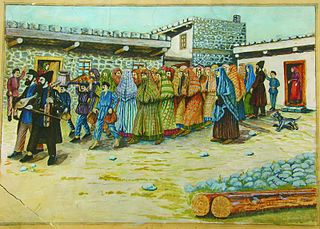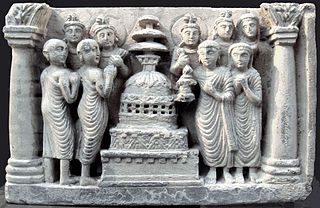
In Christianity, ablution is a prescribed washing of part or all of the body or possessions, such as clothing or ceremonial objects, with the intent of purification or dedication. In Christianity, both baptism and footwashing are forms of ablution. Prior to praying the canonical hours at seven fixed prayer times, Oriental Orthodox Christians wash their hands and face. In liturgical churches, ablution can refer to purifying fingers or vessels related to the Eucharist. In the New Testament, washing also occurs in reference to rites of Judaism part of the action of a healing by Jesus, the preparation of a body for burial, the washing of nets by fishermen, a person's personal washing of the face to appear in public, the cleansing of an injured person's wounds, Pontius Pilate's washing of his hands as a symbolic claim of innocence and foot washing, which is a rite within the Christian Churches. According to the Gospel of Matthew, Pontius Pilate declared himself innocent of the blood of Jesus by washing his hands. This act of Pilate may not, however, have been borrowed from the custom of the Jews. The same practice was common among the Greeks and Romans.

An altar is a table or platform for the presentation of religious offerings, for sacrifices, or for other ritualistic purposes. Altars are found at shrines, temples, churches, and other places of worship. They are used particularly in paganism, Christianity, Buddhism, Hinduism, Judaism, modern paganism, and in certain Islamic communities around Caucasia and Asia Minor. Many historical-medieval faiths also made use of them, including the Roman, Greek, and Norse religions.

Worship is showing regard with great respect, honor, or devotion. This may be encountered in religious settings. In such instances it may represent divine worship; reverence for a divine being or supernatural power. This activity may have other focuses, such as hero worship. Worship may involve one or more of activities such as veneration, adoration, praise, supplication, devotion, prostration, or submission. An act of worship can be performed as simple prayer or through elaborate ceremony, individually, in an informal or formal group, or by a designated leader. The focus of worship is ultimately honoring the subject in some manner.

Ritual purification is a ritual prescribed by a religion through which a person is considered to be freed of uncleanliness, especially prior to the worship of a deity, and ritual purity is a state of ritual cleanliness. Ritual purification may also apply to objects and places. Ritual uncleanliness is not identical with ordinary physical impurity, such as dirt stains; nevertheless, body fluids are generally considered ritually unclean.

Kateri Tekakwitha, given the name Tekakwitha, baptized as Catherine, and informally known as Lily of the Mohawks, is a Catholic saint and virgin who was an Algonquin–Mohawk. Born in the Mohawk village of Ossernenon, in present-day New York State, she contracted smallpox in an epidemic; her family died and her face was scarred. She converted to Catholicism at age nineteen. She took a vow of perpetual virginity, left her village, and moved for the remaining five years of her life to the Jesuit mission village of Kahnawake, just south of Montreal. She was beatified in 1980 by Pope John Paul II and canonized by Pope Benedict XVI at Saint Peter's Basilica on 21 October 2012.

Maundy, or Washing of the Saints' Feet, Washing of the Feet, or Pedelavium or Pedilavium, is a religious rite observed by various Christian denominations. The word mandatum is the first word of the Latin Biblical quotation sung at the ceremony of the washing of the feet: "Mandatum novum do vobis ut diligatis invicem sicut dilexi vos", from the text of John 13:34 in the Vulgate. The ceremony commemorates the commandment of Christ that his disciples should emulate his loving humility in the washing of the feet. The medieval Latin term mandatum, came to apply to the rite of foot-washing on the Thursday preceding Easter Sunday, known in English as "Maundy Thursday" since at least 1530.

In Mormonism, the endowment is a two-part ordinance (ceremony) designed for participants to become kings, queens, priests, and priestesses in the afterlife. As part of the first ceremony, participants take part in a scripted reenactment of the Biblical creation and fall of Adam and Eve. The ceremony includes a symbolic washing and anointing, and receipt of a "new name" which they are not to reveal to others except at a certain part in the ceremony, and the receipt of the temple garment, which Mormons then are expected to wear under their clothing day and night throughout their life. Participants are taught symbolic gestures and passwords considered necessary to pass by angels guarding the way to heaven, and are instructed not to reveal them to others. As practiced today in the Church of Jesus Christ of Latter-day Saints, the endowment also consists of a series of covenants that participants make, such as a covenant of consecration to the LDS Church. All LDS Church members who choose to serve as missionaries or participate in a celestial marriage in a temple must first complete the first endowment ceremony.

In the Latter Day Saint movement, the term ordinance is used to refer to sacred rites and ceremonies that have spiritual and symbolic meanings and act as a means of conveying divine grace. Ordinances are physical acts which signify or symbolize an underlying spiritual act; for some ordinances, the spiritual act is the finalization of a covenant between the ordinance recipient and God.

Washing and anointing is a ritual purification ordinance similar to chrismation that is part of the temple endowment ceremony practiced by the Church of Jesus Christ of Latter-day Saints and Mormon fundamentalists.

The Paschal Triduum or Easter Triduum, Holy Triduum, or the Three Days, is the period of three days that begins with the liturgy on the evening of Maundy Thursday, reaches its high point in the Easter Vigil, and closes with evening prayer on Easter Sunday. It is a moveable observance recalling the Passion, Crucifixion, Death, burial, and Resurrection of Jesus, as portrayed in the canonical Gospels.

The kiss of peace is an ancient traditional Christian greeting, also called the holy kiss, and sometimes the "brother kiss", or the "sister kiss". Such greetings signify a wish and blessing that peace be with the recipient, and besides their spontaneous uses they have certain ritualized or formalized uses long established in liturgy. Many denominations use other forms of greeting to serve equivalent purposes; these include handshakes, gestures, and hugs, any of which may be called a sign of peace.

Ritualism, in the history of Christianity, refers to an emphasis on the rituals and liturgical ceremonies of the Church, specifically the Christian practice of Holy Communion.

In Christianity, worship is the act of attributing reverent honour and homage to God. In the New Testament, various words are used to refer to the term worship. One is proskuneo which means to bow down to God or kings.

A procession is an organized body of people walking in a formal or ceremonial manner.

Circumambulation is the act of moving around a sacred object or idol.
Pierre Cholenec was a French Jesuit missionary and biographer in New France. He ministered to First Nations in present-day Canada, particularly at the village of Kahnawake south of Montreal. He served as superior of the Jesuit residence in Montréal. He is known for writing multiple biographies about Kateri Tekakwitha which contributed to her canonization in 2012 by Pope Benedict XVI.
In Mormonism, the oath of vengeance was part of the endowment ritual of the Church of Jesus Christ of Latter-day Saints. Participants swore an oath to pray for God to avenge the blood of prophets Joseph Smith and Hyrum Smith, who were assassinated in 1844. The oath was part of the ceremony from about 1845 until the early 1930s.

An ordinance is a term used by certain Christian denominations for a religious ritual that was instituted by Jesus for Christians to observe.
In Mormonism, a prayer circle, also known as the true order of prayer, is a ritual established by Joseph Smith that some Mormons believe is a more potent method of prayer that can lead to receiving greater blessings and revelation from God. The ritual involves forming a circle of participants around a person who offers a prayer, usually at an altar in a temple. The members of the circle repeat the words of the prayer.
The Tekakwitha Conference is a Roman Catholic institution that supports Christian ministry among Native Americans, primarily through its annual meeting.















